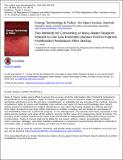Two Methods for Converting a Heavy-Water Research Reactor to Use Low-Enriched-Uranium Fuel to Improve Proliferation Resistance After Startup
Author(s)
Kemp, Ronald S.
Downloadkemp oa article.pdf (310.7Kb)
PUBLISHER_POLICY
Publisher Policy
Article is made available in accordance with the publisher's policy and may be subject to US copyright law. Please refer to the publisher's site for terms of use.
Terms of use
Metadata
Show full item recordAbstract
This article demonstrates the feasibility of converting a heavy-water research reactor from natural to low-enriched uranium in order to slow the production of weapon-usable plutonium, even if the core cannot be physically reconfigured. The analysis was performed for Iran’s IR-40 reactor at Arak in support of negotiations with Iran, but the methods have application to future reactors that present similar nonproliferation challenges. Two methods are considered, and both retain identical power, thermal-hydraulic, and safety profiles as the original reactor design. The conversion options can be implemented at any time during the reactor’s life. The two methods have competing effects on achievable burnup, and they can be combined to produce an optimized core that matches both the fresh-core reactivity and maximum burnup of the original reactor. For the IR-40 example, the optimized design produces weapon-grade plutonium at only about 19% of the rate of the unmodified reactor for the same power level. Additionally, a reactor so converted could not be readily converted back to natural-uranium fuel without replacement heavy water, and it would retain the ability to produce medical isotopes at rates that exceed the original design through the use of LEU targets.
Date issued
2015-04Department
Massachusetts Institute of Technology. Department of Nuclear Science and EngineeringJournal
Energy Technology & Policy
Publisher
Taylor & Francis
Citation
Kemp, R. S. “Two Methods for Converting a Heavy-Water Research Reactor to Use Low-Enriched-Uranium Fuel to Improve Proliferation Resistance After Startup.” Energy Technology & Policy 2, no. 1 (January 2015): 39–46.
Version: Final published version
ISSN
2331-7000